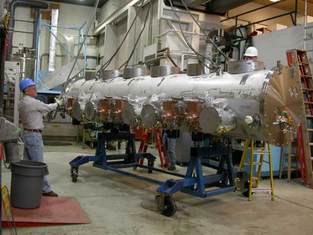Call: 708-425-9080
Meyer Tool Provides Cornell Cryomodule Components
Cold Facts (Spring 2008, Vol. 24 No. 2)
Meyer Tool& Mfg., Inc. has just completed the second of two sets of cryomodule components for Cornell University's Laboratory for Elementary Particle Physics (LEEP) and Cornell's High Energy Synchrotron Source (CHESS). Cryomodule assemblies as defined in a High Energy Physics (HEP) context are the vacuum chamber and internal components that support and insulate the Superconducting Radio Frequency Cavities (SRFC) used in a particle accelerator to accelerate the beam. Cornell is developing a cryomodule for its Energy Recovery Linac (ERL) Injector. The final cryomodule design is expected to contain five-two cell SRF cavities, with two input power couplers per cavity and higher order mode absorbers between cavities. In a two-step process, Cornell commissioned the fabrication of a one-cavity test cryomodule followed by second test cryomodule that will contain five-two cell cavities per the final design. Meyer Tool was contracted to build major components of both test cryomodules.
In 2006-2007 Meyer Tool fabricated key components of the initial test cryostat. In 2007-2008 Meyer Tool built key components of the second test cryostat. These components included the vacuum vessel weldments, the Titanium Helium Gas Return Pipes (HGRP), the internal cryogen pipes, the Support Post Assemblies, and various smaller precision machined components. Special challenges included the titanium HGRP weldments which required precision machining after welding. Surfaces that mounted to the Support Posts and HOM and Cavity Supports on the HGRP required precision machining in relation to each other. Another difficult component was the 38" diameter x 195" long vacuum vessel for the second cryomodule. Twenty-six ports on the vacuum chamber required post-weld machining to precision tolerance to themselves and the other ports.
"Meyer Tool is unique in the cryogenic industry, being to our knowledge the only American company with experience in building cryogenic equipment for High Energy Physics applications which dates back to the 1970s and the construction of Fermilab. This experience manifests itself in the confidence placed in Meyer Tool's long-term skilled employees by Cornell and others, depending on Meyer Tool to provide the lowest total cost of ownership through exceptional quality and service," said Ed Bonnema, Meyer's Vice President of Operations.
In 2006-2007 Meyer Tool fabricated key components of the initial test cryostat. In 2007-2008 Meyer Tool built key components of the second test cryostat. These components included the vacuum vessel weldments, the Titanium Helium Gas Return Pipes (HGRP), the internal cryogen pipes, the Support Post Assemblies, and various smaller precision machined components. Special challenges included the titanium HGRP weldments which required precision machining after welding. Surfaces that mounted to the Support Posts and HOM and Cavity Supports on the HGRP required precision machining in relation to each other. Another difficult component was the 38" diameter x 195" long vacuum vessel for the second cryomodule. Twenty-six ports on the vacuum chamber required post-weld machining to precision tolerance to themselves and the other ports.
"Meyer Tool is unique in the cryogenic industry, being to our knowledge the only American company with experience in building cryogenic equipment for High Energy Physics applications which dates back to the 1970s and the construction of Fermilab. This experience manifests itself in the confidence placed in Meyer Tool's long-term skilled employees by Cornell and others, depending on Meyer Tool to provide the lowest total cost of ownership through exceptional quality and service," said Ed Bonnema, Meyer's Vice President of Operations.








